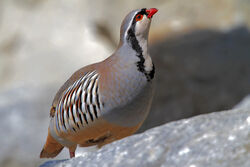| Rock Partridge | |
|---|---|
 | |
| Scientific classification | |
| Kingdom: | Animalia |
| Phylum: | Chordata |
| Class: | Aves |
| Order: | Galliformes |
| Family: | Phasianidae |
| Genus: | Alectoris |
| Species: | Alectoris graeca |
The rock partridge (alectoris graeca) is a bird in the Phasianidae family.
Description
The rock partridge measures about 35 cm in lenght and has a wingspan of about 50-55 cm. The plumage is blueish or light brown in the upperparts and on the breast and white on the throat with a bording black stripe. Underparts are greyish with black and rusty bars.
Habitat
This bird lives in open, rocky, dry mountain slopes, hillsides, or canyon walls from below sea level 3660 m elevation. Steep slopes appear to be preferred. Slope grade is usually over 7 percent with a rise of at least 60 m. The rock partridge is also found on open and flat deserts with sparse grasses. Nesting habitat is similar to foraging habitat: dry, rocky slopes with open, brushy cover, nesting birds and rock partridge broods are normally found within 3 kilometers of water. Rock partridges use rocky slopes for shade and escape cover. The hottest part of the day is usually spent in shady cover. They roost on the ground beneath sagebrush or junipers and in the shelter of rock outcrops. They also roost in open rocky places; dense brush cover is not required and is probably avoided.
Feeding
During the breeding season, rock partridges feed in pairs. Foraging occurs in early morning and late afternoon. In summer and fall the bulk of chukar diets is composed of diffent grass seeds, wild onions and mustards are also consumed. After autumn rains cause grasses to green up, chukars consume large amounts of grass blades and basal shoots, and the bulbs, stems, leaves, and buds of a variety of plants, fruits are consumed during summer. A variety of forb and shrub seeds or fruits are consumed during the winter. Additional items reported for chukar diets include early spring greens, leaves, seeds and other mountain grasses and fruits. Rock partridges do not utilize legume seeds to any great degree, but do consume leaves of alfalfa, clover, and sweetclover. The diet of young ìbirds includes a high proportion of insects; adult birds may consume as much as 15 percent by volume. Animal foods consist primarily of grasshoppers, caterpillars, crickets, ants, and various insect eggs.
Distribution
They only live on South-east Europe mountains.
